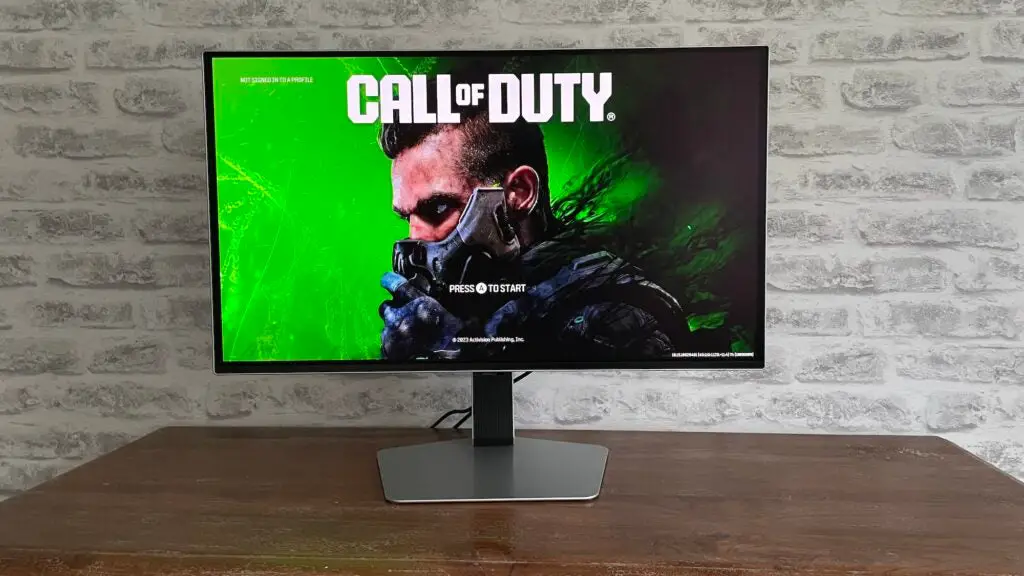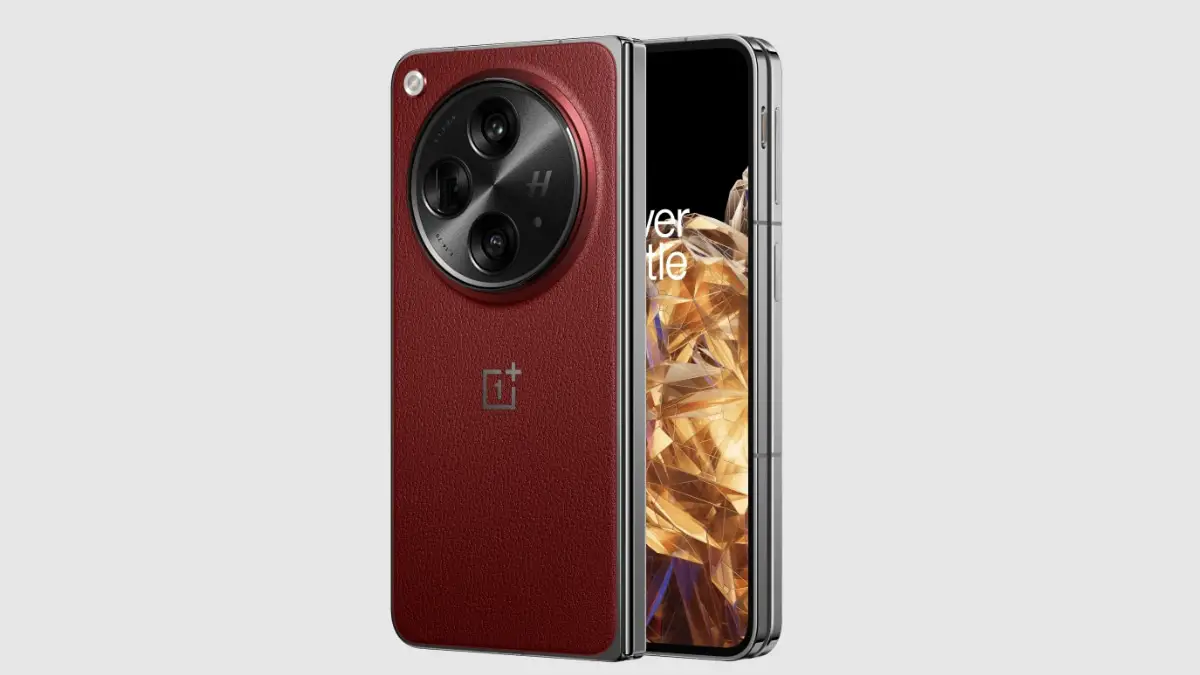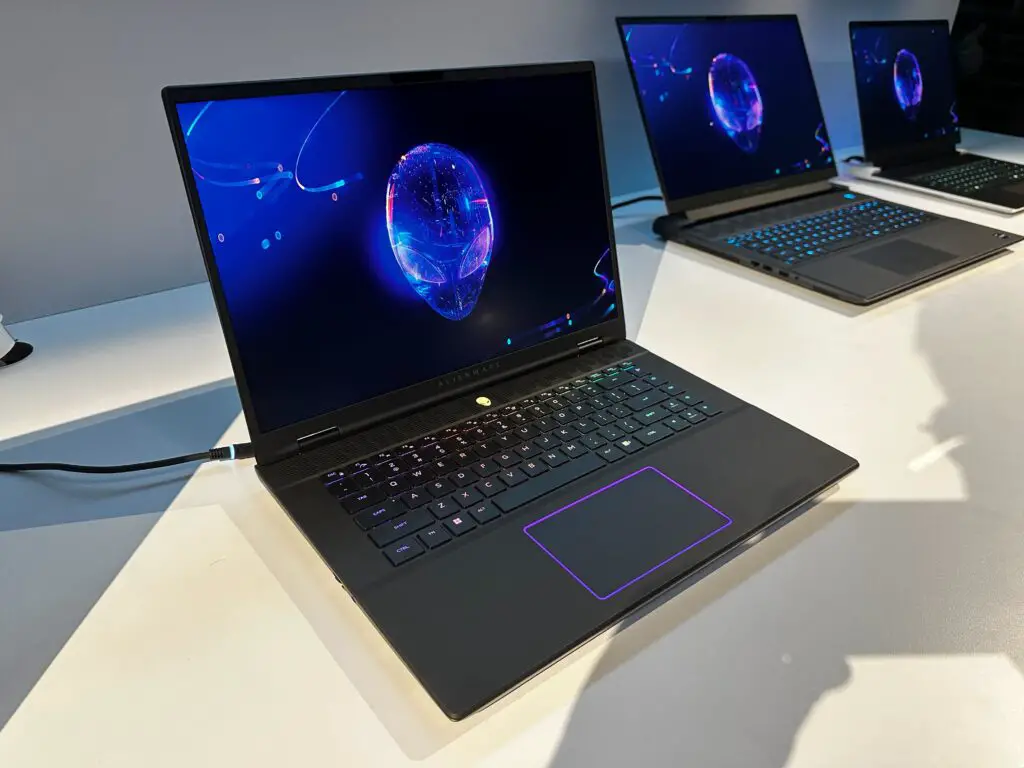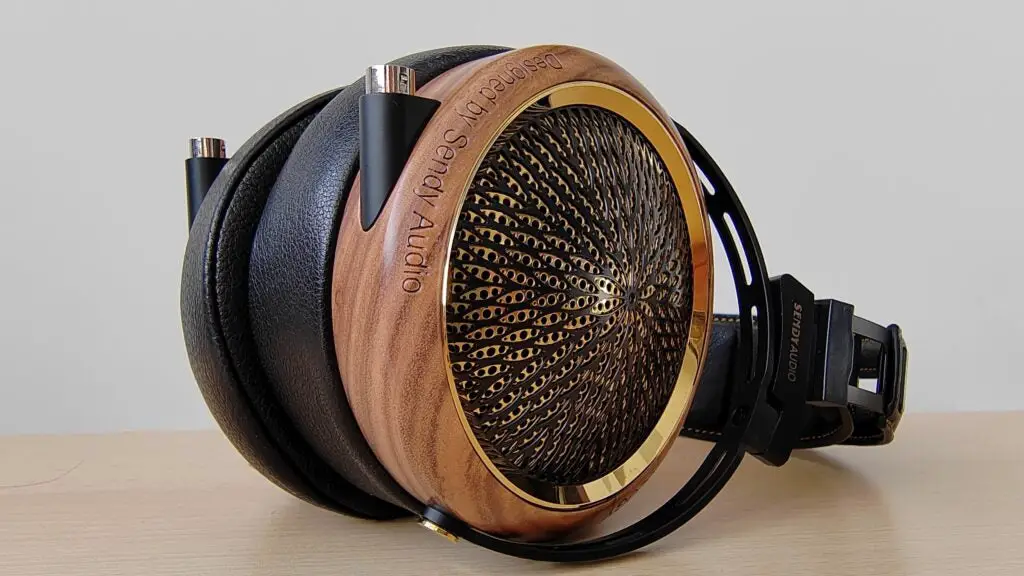Verdict
Ideally the Samsung Odyssey G6 S27G60SD would be far cheaper than its Samsung Odyssey OLED G8 32G80SD sibling given how much more Samsung’s bigger OLED monitor has to offer in size, feature and performance terms.
If you don’t need the S32G80SD’s more advanced video and smart features, though, the S27G60SD is still a brilliant and more focused gaming monitor in its own right – and the £300 you save still equates to a lot of games and other gaming gear.
Pros
- Incredible local contrast and black levels
- Excellent reflection suppression
- Advanced het control system
Cons
- Not as bright as some LED/Mini LED models
- Built-in joystick controller is fiddly to use
- No Dolby Vision support
Key Features
- 16:9 27-inch QD OLED displayThe G6 for 2024 adopts a 16:9 ratio (with a QHD resolution), and uses Samsung’s QD OLED technology where self-emissive blue light is shone through red and green Quantum Dot layers.
- Dynamic cooling systemA so-called pulsating heat pipe array has been built in to the screen that evaporates and condenses coolant to deliver local heat control five times more efficiently than Samsung’s previous Graphite Sheet method. This should hugely reduce the potential for the screen to suffer with OLED screen burn.
- AMD FreeSync Premium ProAs well as the standard HDMI variable refresh rate system, the G6 supports AMD’s FreeSync Premium Pro system.
Introduction
Samsung’s QD OLED screens have made quite an impact on the gaming world in the short two years of their existence. The technology doesn’t usually come cheap, though – so here’s hoping that Samsung’s most affordable QD OLED monitor yet, the 27-inch Odyssey G6 27G60SD, still delivers plenty of the technology’s trademark gaming thrills.
Samsung’s Odyssey range of gaming monitors has been on quite the roll. From the irresistible immersion of the range’s king-sized, ultra wide Mini LED models to the gorgeous, contrast-rich picture quality of its OLED displays, Odyssey monitors have bagged award after award from the technology press. Including us.
This trend continued with the most recent Odyssey model to come our way, the game-changing Samsung Odyssey OLED G8 S32G80SD. At £1099 for a 32-inch monitor, though, awesome as it is, the S32G80SD may simply be beyond most gamers’ budgets. Which is where the S27DG60 comes in.
This 27-inch, flat-screen model is cheaper, yet still offers much of the key specification of its more expensive 32-inch sibling.
Including the fact that it uses one of Samsung’s pure RGB Quantum Dot OLED panels, another strikingly effective glare-free matte screen finish, and the same new Pulsating Heat Pipe technology to keep all the screen’s organic elements nice and cool. It even gets one up on the S32G80SD by supporting 360Hz refresh rates, rather than 240Hz, making it the fastest monitor in the entire Odyssey range.
So is the S27DG60 the ‘bargain’ Samsung Odyssey display we’ve all been waiting for?
Design and Build
- A Startlingly thin screen with a gorgeous premium metallic finish
- Core lighting system on its rear
- Fantastically straightforward screw-free construction
The S27DG60 certainly doesn’t look like a poor relation to the S32G80SD. In fact, aside from sporting a smaller screen, it looks exactly the same. This is great news given that this means it boasts a gorgeously high quality metallic finish for both its hexagonal desktop plate-style ‘foot’ and its sleek, ultra-slim rear panel, as well as a stand mount that offers tilt, swivel, rotate and height adjust features.
The silver metallic trim around the flat screen’s edges is again spectacularly thin, and it’s great to find a circle of LEDs around the large stand attachment point delivering Samsung’s immersive Core lighting system.
While I personally liked to keep the Core Lighting on with the S27DG60 for pretty much the whole time, you can turn it off if it’s not your cup of tea, or you maybe like it for gaming but not video playback.
Remarkably given how thin the S27DH60’s screen is, it still manages to find the space for Samsung’s new Pulsating Heat Pipe system. This condenses or evaporates coolant in different parts of a pipe system that runs behind the screen to deliver much more focused and therefore efficient and effective cooling than a simple heat sink sheet ever could. Resulting, crucially, in the OLED screen being much less likely to suffer from screen burn, where prolonged exposure to bright, static image elements can result in ghostly shadows of those elements remaining permanently visible.
A simple loop strap on the back of the monitor’s neck lets you keep cabling tidy, but maybe my favourite thing about the S27DG60’s design is the way you can put its three elements – plate base, neck and screen – together without needing any screws. Everything just slots together in a matter of seconds.
The S27DG60’s connections are reasonably numerous, giving you two HDMIs (one with eARC capability, for passing audio out to an external ARC-capable sound system), a DisplayPort 1.4 jack, two USB hub ports, and a headphone jack.
My only issue with the S27DG60’s design is that these connections are placed in the middle of the bottom rear edge, making them hard to access. Their position does, though, make it easier to keep cables hidden.
Next to the connections is a small recessed control knob that provides the only way of controlling the S27DG60. Unfortunately, Samsung’s cheapest Odyssey OLED monitor does not ship with a remote control.
Something else the S27DG60 doesn’t have that the S32G80SD does is speakers. So if you want sound to accompany your gaming or video viewing on this monitor, you’ll need an external audio system.
Image Quality
- Fantastic contrast and black levels
- Impressive reflection reduction
- Outstanding gaming motion reproduction
In many ways the S27G60SD serves up the same deliriously good image quality that the S32G80SD did.
So, for instance, you get the same imperious black level performance, where dark environments appear with fantastically deep and rich black tones of a sort no LCD monitor to date can rival.
Having such a perfect dark foundation to its images immediately helps the S27G60SD draw you into today’s sophisticated, often high dynamic range gaming worlds to a degree you just don’t experience with screens that leave dark areas looking grey or riddled with backlight clouds or blooms.
Since every OLED pixel produces its own light, there’s also a consistently impressive amount of shadow detail visible in even the darkest corners of the picture. Hiding enemies receive no help here from the sort of grey mist effect that can hide low-lit details on many monitors.
Profound and natural black levels usually play into rich, natural and consistent colour tones – and so it proves with the S2760SD. HDR gaming worlds can look beautifully intense and vibrant if that’s how they’re supposed to look – but the monitor also has the subtlety to deliver a flatter, subtler and more lived in colour scape.
The monitor proves capable with our Calman Ultimate software and Portrait Displays C6 colorimeter and G1 signal generator of covering 100% of the SDR Rec709 colour scape, 99% of the Adobe RGB colour scape, and a very impressive 99.46% of the DCI-P3 colour gamut used for most HDR mastering.
Both HDR games and video remain free of the sort of colour striping interference that can plague HDR on lesser displays, and the dynamic tone mapping feature does quite a good job of making HDR pictures feel more punchy. Though at the expense of a little subtle shading and detail ‘clipping’ in the very brightest HDR areas.
Motion looks ultra crisp and clear, especially at rates of 60Hz and up, as we’ve come to expect from OLED screens. Don’t forget that this monitor can actually handle frame rates up to an utterly butterly 360Hz – a mind-bending refresh rate that provides a phenomenally responsive gaming experience on PC with titles such as Apex Legends, Overwatch and Rainbow Six Siege.
Most users of the S28G60SD, of course, won’t have the necessary source equipment to unlock its full 360Hz magic. Rest assured, though, that even the now common 120Hz rates also look gorgeously sharp and smooth.
Judder can become a touch jarring with 24p films and 30p games – though the monitor’s support for variable refresh rates helps keep the gaming disruption down by removing picture ‘tearing’ with games featuring low but fluctuating frame rates.
The VRR support officially extends to the AMD Freesync Premium Pro system, and while Samsung doesn’t claim official compatibility with the Nvidia G-Sync VRR system, it actually seemed to work during tests.
Samsung claims a lightning fast 0.03ms GtG response time for the S27G60SD. My own tests with a 1080p/60Hz feed from a Leo Bodnar signal generator recorded an impressive 9.4ms in its Game Standard mode.
While the S27G60SD is certainly first and foremost a gaming monitor, it’s well worth underlining that as with the S32G80SD, it’s also capable of adapting quite beautifully to video playback. It can deliver video picture quality that’s way beyond anything you can currently get from an actual 32-inch or cheaper television.
That said, the S27G60SD doesn’t join the S32G80SD in carrying a built in smart system and video streaming service platform. Nor does it carry any out of the box picture preset that’s quite as accurately set up for video colour and greyscale as some of the S32G80SD’s presets. Even though it provides the option to set it to either PC or AV mode.
It seems reasonable, though, to expect a more single-minded gaming monitor than the specifically more dual-purpose S32G80SD not to have worried quite as much about video tuning and features. Plus the S27G60SD does still have plenty of tuning features to help support a proper video calibration for anyone who wants to go that route.
The one way in which the S27DG60SD’s pictures clearly come up short of those of the S32G80SD is sharpness and detail. Don’t get me wrong: The 27-inch model’s QHD resolution still looks crisp and dense in the context of a compact 27-inch 16:9 screen. But not being able to render 4K games in their full glory does leave them feeling just a little coarser.
The resolution difference is quite noticeable with video sources too, both in a slight reduction in the gorgeous texturing of native 4K content such as the fantastic looking Ripley series on Netflix, and in the appearance of slightly more compression noise generated by the fact that external streaming devices such as Apple TV boxes only recognise Samsung’s display as capable of receiving 1080p/60Hz signals.
The fact that the S27G60SD doesn’t benefit from the same remarkably powerful NQ8 AI Gen 3 processor used in the G80SD surely contributes, too, to the smaller screen’s slightly softer, noisier feel with video footage.
I also felt marginally more aware on the S27G60SD than I was on the S32G80SD of tiny green seepage above and tiny red seepage below very bright, straight horizontal lines in HDR games, presumably caused by the triangular structure of the QD OLED subpixels. Though oddly I never felt any impact from this when looking at text while using the monitor in ‘work mode’.
One other niggle with the S27G60SD is the same as my main niggle with the S32G80SD: It isn’t especially bright. With HDR gaming modes it does solidly, with measurements using a Portrait Displays C6 colorimeter, G1 signal generator and Calman Ultimate software confirming that the screen breaches 450 nits in its Original preset with a 10% HDR test window with HDR tone mapping set to static (though this drops to more like 280 nits with a full-screen bright image).
With SDR, though, the screen struggles to pass 200 nits. In fact, it drops below 100 nits while using many of the monitor’s out of the box settings, which set the default brightness at a very low level six (out of 50!). Seemingly in recognition of the fact that the colour tone starts to look cooler if you increase the brightness much.
If you switch the monitor to its AV mode and choose the Movie preset the screen does helpfully deliver limited time peaks of up to 700 nits. It only manages this for limited time periods over very small areas, but that actually reflects the way brightness peaks often appear in video content. So if you do find yourself starting to use the S27G60SD for video as well as gaming use, be sure to toggle the screen into its AV mode if you want to ‘unlock’ more punch than you get in the monitor’s Game mode.
The way the S27G60SD’s colours work also provides a great incentive to always remember to switch between the screen’s AV and PC modes depending on what you’re using the monitor for, as Calman tests confirm my subjective impression that bright parts of HDR video images can run quite cool (blue) in if the monitor is in Game mode, but retain much more naturalism and accuracy to video values across the brightness spectrum in AV mode. In fact, in AV mode with the Movie preset selected, our Calman Ultimate software recorded a Delta E colour error of just 2.5. That’s low enough to be imperceptible to the naked eye.
Before anyone gets disheartened by what I’ve said about the S27G60SD’s only middling brightness, the impressive extent to which the screen’s matte, anti-glare filter prevents reflections from getting in the way really helps the screen get the most impact from the brightness available to it.
What’s more, the level of brightness you actually feel like you’re seeing from the S27G60SD seems higher than the measured levels, simply because the darkest pixel in a gaming scene can sit right beside the brightest pixel without either disrupting the other.
Interface and Apps
- Faffy joystick control
- Clear onscreen menus
- No remote control or voice control
Let’s start with the bad news here: I really missed not having a remote control. The ’rock to highlight, press to select’ joystick control recessed on the screen’s rear proves very fiddly to get to and even more fiddly to use, especially when it comes to trying to press it in to select an option without simultaneously accidentally moving the joystick so that you end up selecting the wrong option.
The rocker control also didn’t always respond to my button presses, especially if I tried to press the joystick in without first consciously letting it ping back into its neutral central position.
Of course, as part of my reviewing process, I was compelled to make more frequent adjustments to the S27G60SD than regular users would have to. If you’re just using it for gaming, once you’ve got everything set up to your satisfaction you may never need to tinker with anything again. But I couldn’t help but wonder if including a remote control would really have been too much to ask with a still expensive 27-inch monitor.
The S27G60SD doesn’t get the Tizen ‘smart TV’ OS sported by the 32G80SD. This means that as well as not getting any of the built-in video streaming apps that are such a big part of the Tizen OS platform, the S27DG60SD doesn’t get the Game Hub: A dedicated interface page that brings together all the gaming sources available to the monitor.
Also missed is the slick Game Bar dedicated menu screen that you can call up when gaming on the S32G80SD (or recent Samsung TVs like the Q80D). Game features do still appear at the top of the S27G60SD’s menus, but the presentation is less elegant and straightforward, and the number of gaming aids supported is reduced.
You do still get, though, support for Ultra Wide View gaming from PC titles that support it, a virtual aim point, and a Black Equaliser feature that can make dark areas of a game specifically look a little brighter without affecting the rest of the picture.
One final quirk Xbox Series X owners thinking of partnering their console with an S27G60SD need to be aware of is that strangely you can only retain 4K and HDR playback support from Microsoft’s console if you turn off Freesync support in the S27G60SD’s menus. So you can’t have Freesync VRR support at the same time you can have the console’s highest resolution and HDR support.
Latest deals
Should you buy it?
You should buy it because it delivers stellar image quality without onscreen reflections
OLED’s self-emissive pixels allow the S27G60SD to produce incredible contrast and black levels, while a special matte filter cuts out distracting onscreen reflections.
You should not buy it as it’s fiddly to control, and isn’t as bright as some LCD monitors
There’s no remote control, and the joystick on the back of the screen is awkward to use. And while its contrast is peerless, it can’t produce as much flat out brightness as some premium LCD screens.
Final Thoughts
While I’d say Samsung’s S32G80SD OLED Odyssey monitor is worth the extra money if you can afford it, the S27G60SD is a great way of getting your hands on Samsung’s imperious new OLED monitor image quality for less money. If you’re not interested in the PC/AV ‘crossover’ talents of the S32G80SD, you might also prefer the S27G60SD’s tighter gaming focus.
How we test
We use every monitor we test for at least a week. During that time, we’ll check it for ease of use and put it through its paces by using it for both everyday tasks and extended gaming sessions. We also check its colours and image quality with a Portrait Displays C6 colorimeter, G1 signal generator and Calman Ultimate software to test its coverage and the display’s quality.
We used it as our main monitor for 14 days.
We used a Portrait Displays C6 colorimeter to get benchmark results.
You might like…
FAQs
What is Samsung’s Dynamic Cooling System?
A combination of processing identifies and adjusts the brightest parts of the picture while a new piped cooling system expands or contracts coolant as and exactly where required to maintain consistent screen temperature more efficiently than traditional heat sink systems.
Does the 27G60SD support variable refresh rates?
Yes – in the standard HDMI and AMD FreeSync Premium Pro variations. NVidia G-Sync isn’t officially supported, but appears to work!
What is Quantum Dot OLED?
Samsung’s home-grown relatively new variation on OLED technology shines a blue organic light through layers of red and green Quantum Dots to create a pure RGB colour system.
Does the 27G60SD support HDR?
Yes, in the HDR10 and HDR10+ variations. There is no support for Dolby Vision.
Full specification
UK RRP
USA RRP
EU RRP
CA RRP
AUD RRP
Manufacturer
Screen Size
Size (Dimensions)
Weight
Release Date
First Reviewed Date
Model Number
Resolution
HDR
Types of HDR
Refresh Rate
Ports
Connectivity
Colours
Display Technology
Syncing Technology
Samsung S27G60SD
£799
$899.99
€895
CA$949.99
AU$1499
Samsung
27 inches
611.7 x 49.2 x 353.8 MM
3.8 KG
2024
08/08/2024
Samsung Odyssey 27G60SD
2560 x 1440
Yes
HDR10, HDR10+
360 Hz
DisplayPort 1.4, two HDMI ports, headphone port, two USB 3.0 hub ports
DisplayPort 1.4, two HDMI ports, headphone port, two USB 3.0 hub ports
Silver
OLED
AMD FreeSync
Jargon buster
QD-OLED
QD-OLED or Quantum Dot display is an emissive display that combines Quantum Dot colour technology and OLED-like contrast, viewing angles and perfect blacks. QD-OLED can also hit brighter overall and peak levels for HDR content
Variable Refresh Rates
Variable Refresh Rate enable a game console/PC to send video frames as quick as possible to a display, with the screen adapting its own refresh rate in real-time to match the source, reducing visual artefacts and offering a more responsive performance
Colour Gamut
The range of colours an output device is capable of reproducing.










